The Prophet Like Moses
The Transfiguration
by Jeffrey J. Harrison

One of the most beautiful places in Israel is the Golan Heights. It’s a high, grassy plain that overlooks the Sea of Galilee and stretches all the way up to Mt. Hermon, the highest mountain in Israel. But the name Golan
can also be used to include the lowlands below the heights, the many cliffs and steep slopes leading up to the heights, and the slopes of Mt. Hermon itself. This challenging terrain, both the slopes and the heights above, is home to abundant wildlife. There’s a good chance of spotting gazelle, wild boar, and different kinds of eagles, not to mention the funny little rock badgers that live among the rocks, more properly known as hyrax (see photo above).*
* In Hebrew, shephanim (שְׁפַנִּים). Sometimes translated conies,
coneys,
or simply as badgers
(Lev. 11:5, Deut. 14:7, Psa. 104:18, and Pro. 30:26).
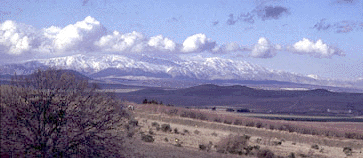
One of the reasons the Golan abounds with wildlife is that most of the Syrians living there were pulled out before the Six-Day War in 1967, with the exception of a few Druze* villages. The Jews that settled there after the war clustered in a few small areas for defensive purposes, leaving large sections of the Golan open terrain.
* The Druze are an esoteric mystery religion that broke off from Islam a thousand years ago. Their holy prophet is Jethro, the father-in-law of Moses, whose tomb they believe is located at the Horns of Hattin Mountain near the Sea of Galilee. Their beliefs are connected with the sixth Fatimid caliph, Al-Hakim, who had the Church of the Holy Sepulcher, site of Jesus' crucifixion and resurrection, destroyed in 1009 AD.
This greater Golan, known in the time of Jesus as Gaulanitis, is one of the areas he visited when he withdrew from the growing opposition against him in Galilee. Matthew tells us he spent time near the capital of the region, Caesarea Philippi (Matt. 16:13). This was the largest city in the area, in the lowlands at the foot of Mt. Hermon. But Jesus and his disciples most likely spent most of their time in the small Jewish villages nearby (the district
), some of which perched on slopes leading to the heights above.
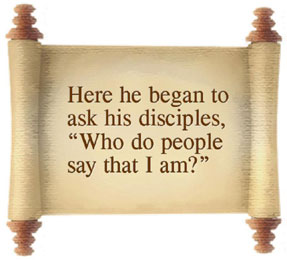
Here he began to ask his disciples, Who do people say that I am?
(Matt. 16:13, Luke 9:18). They answered with the names of well-known prophets of the past, including John the Baptist, Elijah, and Jeremiah (Matt. 16:14, Luke 9:19). Why John? By this time, John the Baptist was already dead, killed by Herod Antipas, the ruler of neighboring Galilee (Matt. 14:1-12). This means that all the names that people offered to identify Jesus were the names of dead prophets, thinking that one of them had miraculously come back to life. But why would they identify Jesus as a dead prophet raised to life? Why not a new prophet?
Their interest in a prophet raised from the dead came from one of the most popular Messianic prophecies, delivered by Moses himself: The Lord your God will raise up for you a prophet like me from among you, from your brothers; you will listen to him
(Deut. 18:15). They understood that the words God will raise up
meant that this prophet would be raised from the dead. This would not be an ordinary prophet, but a prophet like Moses, with the ability to interpret and clarify God’s instructions in the Law. This contributed to the expectation of many that the Messiah would deliver a new and updated version of the Law: a Law for the Messianic age.
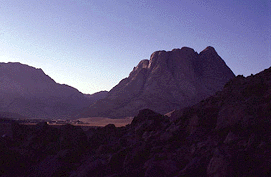
This difference between Moses and the other prophets is explained in Numbers 12:8: With him I speak mouth to mouth and openly, and not in dark sayings; and he sees the form of the Lord.
Moses did not hear from God in dreams and visions that were hard to understand. God spoke to him openly and directly. But what does it mean that Moses saw the form
of the Lord? This is a reminder of the direct intensity of Moses’ interactions with God, one of the most dramatic of which took place in Exodus 33 and 34, when the children of Israel were camped at the foot of Mt. Sinai.
This was after the incident of the golden calf, when Moses had smashed the tablets, and then went back up the mountain to repent before God on behalf of the people. But the Lord told him that the plan had now changed; he would no longer go up with them to Israel, because you are a stiff-necked people, lest I destroy you on the way
(Exo. 33:3). This message was met with grief in the Israelite camp, and no less on the part of Moses himself (Exo. 33:4,15-16). As a result, Moses pitched the tent of meeting outside the camp, reflecting God’s rejection of the people (Exo. 33:7). Yet God continued to meet there with Moses, the pillar of cloud descending to the tent of meeting, while all the people looked on from the Israelite encampment (Exo. 33:8-10).
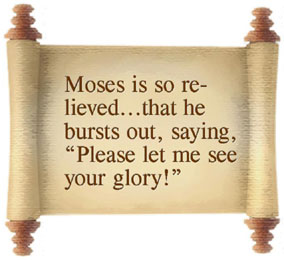
But Moses didn’t give up trying to persuade God to return to the original plan, in which God would accompany the people to Israel. He reminded the Lord of the favor in which God had said he held him personally, and that Israel was his people (Exo. 33:12-13). Finally, God relented, saying, My face [or presence] will go with you
(Exo. 33:14). Moses is so relieved by this change that he bursts out, saying: Please let me see your glory! (Exo. 33:18)
To this, surprisingly, God agrees. And they begin to plan one of the most exciting moments in human history. God will make his goodness
pass over (or before) Moses, while he (God) calls out in the name of the Lord (Exo. 33:19). But the wording here seems a little strange. Why would God call out in his own name? And what exactly is his goodness
?
There was a limit, though, to what God would reveal to Moses. He would not show him his face, for man cannot see me and live
(Exo. 33:20). So instead God instructs Moses to stand beside him on the rock, so that when his glory
passes over, he can overshadow him with his hand.
In this way, he would not see too much of God's glory while he was passing by (Exo. 33:21-22). Here again the wording is strange. How can God be standing beside Moses on the rock, overshadowing him, while he himself is passing by? It sounds like God will be in two places at once.
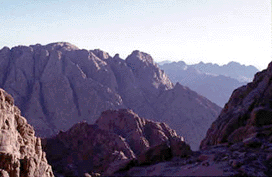
The big event was set for the next day, in the morning (Exo. 34:2). Morning is the best time to climb the mountains of Sinai. In the early morning hours, the desert is still cool and pleasant. But later in the day it gets scorching hot. At the traditional Mt. Sinai, there is none of the abundant grass that covers the Golan. This is deep desert, where it is extremely dry. The mountains are solid chunks of rock that jut up from the desert floor. From the top of the mountain, there is a beautiful view that stretches on and on for up to ninety miles on a clear day.
When Moses reached the top of the mountain, God descended in the cloud and stood there beside him, as planned (Exo. 34:5). This seems to be the same pillar of cloud that appeared to Moses at the entrance of the tent of meeting (Exo. 33:9), the same pillar of fire and cloud that led the children of Israel through the desert (Exo. 13:21). From the cloud, the Lord called out in the name of the Lord (Exo. 34:5). In response, the Lord passed over above him (Exo. 34:6). This second appearance of the Lord appears to be quite distinct from the first one. Remember, the job of the first appearance of the Lord, the Lord in the cloud, was to overshadow Moses, so he would not see God’s face. But the Lord passing by overhead is not in a cloud, but revealed in all his goodness
or glory.
There are clearly two distinct appearances of the Lord here: the Lord hidden in the cloud next to Moses and the Lord revealed overhead. This mystery may be confirmed by the words the Lord himself cried out: Lord, Lord, a compassionate and gracious God
(Exo. 34:6). There are two Lords, yet one God. This seems to be the way Moses also understood this experience: in vs. 9, he, too, mentions two Lords: Lord, if I have found favor in your sight, please let the Lord walk among us
(Exo. 34:9). In other passages, he does not address God in the third person. Why the switch of language here? The simplest explanation is that Moses is asking Lord #1, the one in the cloud, if Lord #2, the face
or glory
of God, can go with them.
The rabbis after the time of Jesus explained such puzzling epiphanies as the activity of angels operating in the Lord’s name. But the early Jewish believers in Jesus, and Christianity after them, understood that these two Lords, the one in the cloud
and the face
(or glory) of God, were in fact God himself as the New Testament describes him: one the Holy Spirit (in the cloud) and the other the Word or Son of God (the face or glory of God): Two Lords manifesting the invisible Father, yet all together are one God.
The effect of this incredible experience was dramatic: Moses’ face shone so brightly that it frightened the others when he came back down the mountain (Exo. 34:30). No other prophet ever had an experience like this—until Jesus went up into the Golan.
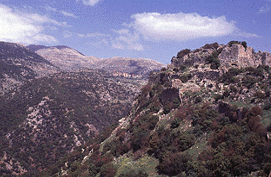
Just a few days after asking his disciples, Who do people say that I am?
, Jesus went up one of the steep slopes rising up to Mt. Hermon (Luke 9:28).* The solid bedrock of the mountain is exposed nearly everywhere. Plants and small trees grow out of cracks and cavities in the rock here and there. This was one of Jesus’ all-night prayer vigils. The disciples soon fell asleep (Luke 9:32). But while he was praying, his face was changed and his clothing began to glow (Luke 9:29). This must have been quite a spectacle against the starry mountain sky. Matthew says his face shone like the sun (Matt. 17:2). Does that remind you of anything? It’s a hint back to Moses’ experience at Sinai (Exo. 34:30).
* The gospel accounts don’t match the traditional site of the Transfiguration on Mt. Tabor. Matthew and Mark imply instead that it was in the Golan near Caesarea Philippi (Matt. 16:13, Mark 8:27). Besides, there was a city on Mt. Tabor at the time, Itabyrium, one of the strongest Zealot cities (Josephus, Wars 4:54-61). But the gospels say they were alone on the mountain (apart by themselves
; Mark 9:2). Also, Matthew and Mark both specify that this was a high mountain,
which, compared to its neighbors in Israel, Tabor is not (Matt. 17:1, Mark 9:2).
Next to Jesus appeared Moses and Elijah in glory,
a code word for heavenly splendor (Luke 9:31). Elijah too, like Moses, had had his own experience on Mt. Sinai when he ran away from Queen Jezebel (1 Kings 19:9-18). But this time, instead of God ministering to them, Moses and Elijah minister to Jesus, preparing him for the final phase of his ministry in Jerusalem (Luke 9:31).
When Peter and the others awake, they see Jesus’ glory
(Luke 9:32). This, too, is a hint back to Sinai and the appearance of the glory
of God. But no sooner do they drink in this sight then a cloud appears and overshadows
them (Luke 9:34). This, too, is a hint to Mt. Sinai. Just as with Moses, God in the cloud hides them from the glory.
Here again there are two Lords, one in the cloud and the other the face
or glory
of the Lord revealed in Jesus.
Then, out of the cloud comes a voice: This is my son, my chosen, listen to him
(Luke 9:35). Notice the words used here: Listen to him.
Does that sound familiar? It’s a hint back to the prophecy of the prophet like Moses: the one of whom Moses says, Listen to him
(Deut. 18:15). Could the message be any clearer? Jesus is the prophet like Moses. Jesus is the one we should listen to.
This revelation in the Golan helps us understand the revelation at Sinai. The face, the glory, the goodness of God that appeared at Sinai is Jesus, the Son of God. Together with God in the cloud, they are two Lords, manifesting the hidden Father, yet all together are one God.* Wow! What an awesome experience and what an awesome message!
* The third Lord of the Christian Trinity, the Father, is hidden in the heavens, just as the rabbis also considered him to be (man cannot see me and live,
Exo. 33:20). Yet Christians believe he reveals himself through his two arms
: the Son and the Spirit. The imagery of God’s arms
is developed by Isaiah in Isa. 51:5,9; 52:10; 53:1; 59:16, etc.
The word used for listen
in the prophecy of the prophet like Moses is shma (Deut 18:15). This Hebrew word means not only to hear, but also to obey. As Jesus himself said, Everyone who hears these words of mine and does them...
(Matt. 7:24). Jesus’ words can sometimes be a little overwhelming, as when he challenges us to lose
our lives for his sake (Matt. 10:38-39). But God sent not only the glory of his Word. He also sent the comfort of his Holy Spirit to stand beside us and empower us to do what Jesus commands us to do. With these two at our sides—the Word and the Spirit—we cannot fail. And don’t be surprised if your face starts to shine a little, too!